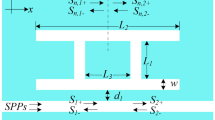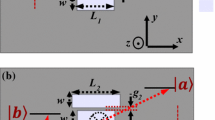Abstract
Combining with tight-binding approach, novel multichannel plasmonic filters are designed by inserting identical coupled cavities between metal-insulator-metal waveguides. We show that the eigenmodes of the plasmonic cavities will asymmetrically split under their coupling with each other. Such an asymmetrical mode splitting provides strongly correlated transmission channels which can be manipulated simultaneously. All channels will red shift or blue shift with the changing of the lengths or widths of the rectangular cavities. The intervals of the channels can be tuned by adjusting the coupling strength of the cavities. Both finite difference time domain method and transfer matrix method are used to investigate the considered plasmonic system. Our results may have important applications in the fields of high-density plasmonic integration circuits and nonlinear plasmonic devices.






Similar content being viewed by others
References
Barnes WL, Dereux A, Ebbesen TW (2003) Surface plasmon subwavelength optics. Nature 424:824–830
Raether H (1988) Surface plasmons on smooth and rough surfaces and on gratings. Springer, Berlin
Genet C, Ebbesen TW (2007) Light in tiny holes. Nature 445:39–46
Lu H, Liu XM, Wang LR, Gong YR, Mao D (2011) Ultrafast all-optical switching in nanoplasmonic waveguide with Kerr nonlinear resonator. Opt Express 19:2910–2915
Veronis G, Fan S (2005) Bends and splitters in metal-dielectric-metal subwavelength plasmonic waveguides. Appl Phys Lett 87:131102
Gao HT, Shi HF, Wang CT, Du CL, Luo XG, Deng QL, Lin XD, Yao HM (2005) Surface plasmon polaritons propagation and combination in Y-shaped metallic channels. Opt Express 13:10795–10800
Han ZH, He SL (2007) Multimode interference effect in plasmonic subwavelength waveguides and an ultra-compact power splitter. Opt Commun 278:199–203
Zhao HW, Guang HJT (2008) Novel optical directional coupler based on surface plasmon polaritons. Phys E 40:3025–3029
Han ZH, Liu L, Forsberg E (2006) Ultra-compact directional couplers and Mach-Zehnder interferometers employing surface plasmon polaritons. Opt Commun 259:690–695
Ditlbacher H, Krenn JR, Schider G, Leitner A, Aussenegg FR (2002) Two-dimensional optics with surface plasmon polaritons. Appl Phys Lett 81:1762–1764
Park J, Kim H, Lee B (2008) High order plasmonic Bragg reflection in the metal-insulator-metal waveguide Bragg grating. Opt Express 16:413–425
Han ZH, Forsberg E, He SL (2007) Surface plasmon Bragg gratings formed in metal–insulator–metal waveguides. IEEE Photon Technol Lett 19:91–93
Neutens P, Dorpe PV, Vlaminck I, Lagae L, Borghs G (2009) Electrical detection of confined gap plasmons in metal-insulator-metal waveguides. Nat Photonics 3:283–286
Zia R, Schuller J, Chandran BM (2006) Plasmonics: the next chip-scale technology. Mater Today 9:20–27
Lin XS, Huang XG (2008) Tooth-shaped plasmonic waveguide filters with nanometeric sizes. Opt Lett 33:2874–2876
Xiao SS, Liu L, Qiu M (2006) Resonator channel drop filters in a plasmon-polaritons metal. Opt Express 14:2932–2937
Hosseini A, Massoud Y (2007) Nanoscale surface Plasmon based resonator using rectangular geometry. Appl Phys Lett 90:181102
Wang TB, Wen XW, Yin CP, Wang HZ (2009) The transmission characteristics of surface plasmon polaritons in ring resonator. Opt Express 17:24096–24101
Noual A, Akjouj A, Pennec Y, Gillet JN, Djafari-Rouhani B (2009) Modeling of two-dimensional nanoscale Y-bent plasmonic waveguides with cavities for demultiplexing of the telecommunication wavelengths. New J Phys 11:103020
Lu H, Liu XM, Gong YK, Mao D, Wang LR (2011) Enhancement of transmission efficiency of nanoplasmonic wavelength demultiplexer based on channel drop filters and reflection nanocavities. Opt Express 19:12885–12890
Gong YK, Liu XM, Wang LR (2010) High-channel-count plasmonic filter with the metal-insulator-metal Fibonacci-sequence gratings. Opt Lett 35:285–287
Luo X, Zou XH, Li XF, Zhou Z, Pan W, Yan LS, Wen KH (2013) High-uniformity multichannel plasmonic filter using linearly lengthened insulators in metal-insulator-metal waveguide. Opt Lett 38:1585–1587
Lu H, Liu XM, Wang GX, Mao D (2012) Tunable high-channel-count bandpass plasmonic filters based on an analogue of electromagnetically induced transparency. Nanotechnology 23:444003
Lidorikis E, Sigalas MM, Economou EN, Soukoulis CM (1998) Tight-binding parametrization for photonic band gap materials. Phys Rev Lett 81:1405–1408
Bayindir M, Temelkuran B, Ozbay E (2000) Tight-binding description of the coupled defect modes in three-dimensional photonic crystals. Phys Rev Lett 84:2140–2143
Chen YH, Dong JW, Wang HZ (2006) Omnidirectional resonance modes in photonic crystal heterostructures containing single-negative materials. J Opt Soc Am B 23:2237–2240
Palik GP (1985) Handbook of optical constants of solids. Academic, Boston
Zhang Q, Huang XG, Lin XS, Tao J, Jin XP (2009) A subwavelength coupler-type MIM optical filter. Opt Express 17:7549–7554
Tao J, Huang XG, Zhu JH (2010) A wavelength demultiplexing structure based on metal-dielectric-metal plasmonic nano-capillary resonators. Opt Express 18:11111–11116
Taflove A, Hagness SC (2000) Computational electrodynamics: the finite-difference time-domain method. Artech House Publishers, Boston
Bethune DS (1989) Optical harmonic generation and mixing in multilayer media: analysis using optical transfer matrix techniques. J Opt Soc Am B 6:910–916
Born M, Wolf E (1999) Principles of optics. University Cambridge, Cambridge
Ashcroft NW, Mermin ND (1976) Solid State Physics. Sounders, Philadelphia
Khitrova G, Gibbs HM (1999) Nonlinear optics of normal-mode-coupling semiconductor microcavities. Rev Mod Phys 71:1591–1639
Acknowledgments
This work was supported by National Natural Science Foundation of China (Grant No. 11274126) and Natural Science Foundation of Guangdong Province of China (Grant No. 9151063101000040).
Author information
Authors and Affiliations
Corresponding author
Additional information
Zhao Zhang and Fenghua Shi contributed equally to this work.
Rights and permissions
About this article
Cite this article
Zhang, Z., Shi, F. & Chen, Y. Tunable Multichannel Plasmonic Filter Based on Coupling-Induced Mode Splitting. Plasmonics 10, 139–144 (2015). https://doi.org/10.1007/s11468-014-9787-z
Received:
Accepted:
Published:
Issue Date:
DOI: https://doi.org/10.1007/s11468-014-9787-z




